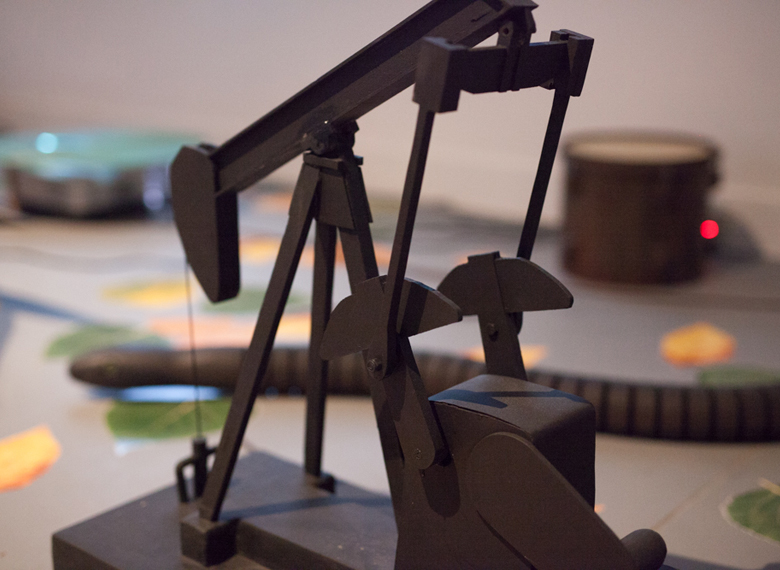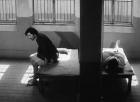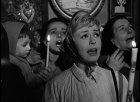The facts are sonorous but between the facts there's a whispering
- Clarice Lispector
Standing in the entrance of the room I sense a strong current of conviction. Rita McKeough's exhibition Veins is a carefully composed maquette of land, filled with sounds and various inhabitants. Space is divided in half by an asphalt road, either side populated by woodland creatures, snakes, aspen leaves, train tracks, "tree-trunk-drums," and a pump jack (aka nodding donkey, oil horse, donkey pumper, horsehead pump, rocking horse, dinosaur, grasshopper pump, thirsty bird, or cricket). Snakes are resolutely moving towards a single vantage point, the end of which is unknown. A quintessential Albertan scenery. It is a land that houses life, a land rendered with theatrical flair: gargantuan aspen leaves, pipeline snakes, train tracks the scale of that which is seen from aerial view, a view opposed by the large wall projections of animated animals. A land of pipelines running across the whole body like veins. It is a sonorous space bursting with movement and layers of sound.
As I walk down this centre line I have the feeling of being watched. Perhaps it is my orientation in the room. Or it must be the animated animals on the wall; they are winking or blinking, their eyes on me. Whispering and growling, as if I am walking through a land thick with life, low growls of hidden predator reaching the eardrums. It is kind of ominous chanting, falling...into the river, falling, falling...into the hole. There is madness in the air, all of its disparate elements smothered with a sense of doom. The slithering black body of the snake clack-clack-clack. The "tree trunks," or the drums with motorized sticks softly thumping, almost like a war signal. I realize that I, as human, am an antagonist.
The whole installation reminds me of our situation in the anthropocene, the proposed epoch in which there are no spaces, processes, or cycles that have not yet met the human reach, thereby leaving the natural forever exposed by humanity’s altering rays. The Earth contains a logic of finite materiality and entropy, yet this era has expedited natural processes and consumption (materials even hauled out of Earth's sphere into outer space), an unprecedented paradigm which makes the future purely unimaginable. It seems that the only way to deal with imminent doom is to deny its coming, to forever delay it by continuing to uphold human systems of capitalism, production, consumption: a notion which heightens the split between civilization and nature, and an ever-increasing sense of antagonism.
I feel the scrutiny of critters in the animation who playfully blink, and jiggle their faces—an innocent but probing gaze. The wriggling woodenness of the black snakes and the sheer size of aspen leaves triggers the imagination to conjure mutant byproducts of an impaired land. Taking in the post-apocalyptic, anarchic surroundings, I become aware of silent antagonisms, antagonisms we should be cognizant of all the time but brush aside because they are silent and invisible. The antagonism and hostility is only subtle but is somehow fully activated and articulated in the viewer: the oil empire, proposals of pipelines and economic growth strictly in opposition to concerning voices. That debate is an old one engrained in the collective psyche of the Western world, a question purported back and forth between the main stakeholders of system and its implicated individuals. In the exhibition the onus of guilt and self-awareness is placed on the viewer, the individuals. The activation of guilt is activation of a moral subject. It is a giant problem to tackle, individual agency seems compromised but yet here we have to face it again as individuals.
The low growl escalates into furious barking.
The music running through the installation sings a particular narrative of premonition: an ominous chanting, whispering, a chorus, burst of vicious growl, small noises of movement that indicate the various bodies of the performers. Against this, the chugging of the machinery automating the disparate elements in the installation poses a subtle threat. The tree-drums tap syncopated beats to the rest of the sound track. The land is the agent of music. The animals are singing and speaking, and I must be the listener now. And through these various makeshift voices a reminder: of speaking beings, agency and thus, dignity.
I realize that I, as human, am an antagonist.
While the whole thing seems to point to a bad ending, embedded in the exhibition is a new proposal. The aspen leaves reveal both dried up and still-green veins of their livelihood. Listen closely to all the sound that is happening and realize that it sounds like the pulsing of a giant heartbeat—the installation as a small mockup or mimesis of land and life. The ancient Greek word mimesis, before it has been bleached to signify a mere copy, the original meaning was more closely linked to action. Originating choreographic and musical rituals of Dionysus, mimesis is the repeated performance of the rituals. Mimesis indicated the act of expressing the bodily, corporeal affect, deep feeling and emotion. It was music and dance, expression of primordial feeling in communion with others. Mimesis is the centrifugal force that emanates from within the subject to the exterior. It calls for a community of feeling. The music in the exhibition contains both human and animal sound. Though the exhibition constructs the animals as the main performers, there is room for our participation, a call for humanity's solidarity with nature. In this mimesis of land, we are invited to listen, sing along to the music that runs through the veins of land; the bloodstream of all life forms, trickling into one composition.
A turning point for the exhibition: sudden silence. The 16-minute sound loop is over, automated components come to a halt. It is a moment to consider the next step: the transition from being a moral subject to moral agent. If something in the artwork triggered a sense of antagonism, guilt, empathy, communion, how do I then bring action? I'd like to quote Hannah Arendt's statement on action: "No other human performance needs speech to the same extent as action."1 According to Arendt, action is the convergence of word and deed; that speech is the declaration of intention or program, something that has power to cause and organize action. Arendt emphasizes the fact that speech needs individual speakers or actors to declare intention into the public sphere. By this we can forever begin again, reimagine and reassert our agency. This causation to begin, I believe is the function of art. Backtracking from the postmodernist ideal of death of the author, let us go back to the first speech act: the artist. The artist delivers a carefully composed speech into the public sphere. Taking this first utterance as cue we then go on to declare something ourselves, and through this we continuously re-envision our agency and create a collective strength for political action.
The picture is of the oil empire sinking in Alberta, empty office towers in downtown Calgary, a looming cloud of recession over our heads; and the immediate remedy—hyper-inflating the system to stay afloat—seems more and more tasteful. Meanwhile the complexity of the global socioeconomic and environmental oil empire crash is leaving some countries in the throes of irreparable unrest. More than knee deep in the system, it's hard to find a place to begin—how do we ever assert ourselves, any utterance that cracks the surface? McKeough, in conversation, recounted for me her memory of Calgary’s protest against the Vietnam War in Riley Park, where people would gather every Sunday to hold hands in a giant circle spanning the perimeters of the park. Affirming their solidarity for peace and collective strength in this circle, the crowd would then march to the U.S. Embassy in protest. This beautiful image still carries weight in McKeough’s practice: utterance, collective action, and the gravity of these elements in the public sphere. It is not surprising to see how much conviction, genuine worry and sincerity Veins fosters, throwing into being questions of how to feel, how to act, ever-renewing the potentiality of empathy, collectivity, community, and solidarity with all forms of life.
Rita McKeough is a Calgary-based audio, media installation and performance artist. She has exhibited throughout Canada since the late 1970s. Her work has been featured in Radio Rethink: Essays on Art, Sound and Transmission (Banff Centre for the Arts, 1993) and Caught in the Act: Canadian Women in Performance (YYZ Books, 2004). Born in Antigonish, Nova Scotia, McKeough received her BFA at The University of Calgary and her MFA at Nova Scotia College of Art and Design. Her experience as a radio station disc jockey and drummer led to the introduction of sound elements into her elaborate installations and later to the development of electronic and mechanical objects in interactive environments. She is currently in the band Sleepy Panther with her wonderful friend Richard Brown and teaching at The Alberta College of Art and Design. Rita insists that she has been fortunate to have the support and assistance of her friends and community to produce her work.




